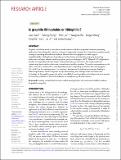| dc.contributor.author | Duan, Jian | |
| dc.contributor.author | Zheng, Yuheng | |
| dc.contributor.author | Luo, Wei | |
| dc.contributor.author | Wu, Wangyan | |
| dc.contributor.author | Wang, Tengrui | |
| dc.contributor.author | Xie, Yong | |
| dc.contributor.author | Li, Sa | |
| dc.contributor.author | Li, Ju | |
| dc.contributor.author | Huang, Yunhui | |
| dc.date.accessioned | 2021-10-27T19:51:33Z | |
| dc.date.available | 2021-10-27T19:51:33Z | |
| dc.date.issued | 2020 | |
| dc.identifier.uri | https://hdl.handle.net/1721.1/133218 | |
| dc.description.abstract | © The Author(s) 2020. Published by Oxford University Press on behalf of China Science Publishing & Media Ltd. This is an Open Access article distributed under the terms of the Creative Commons Attribution License (http://creativecommons.org/licenses/by/4.0/). Graphite and lithium metal are two classic anode materials and their composite has shown promising performance for rechargeable batteries. However, it is generally accepted that Li metal wets graphite poorly, causing its spreading and infiltration difficult. Here we show that graphite can either appear superlithiophilic or lithiophobic, depending on the local redox potential. By comparing the wetting performance of highly ordered pyrolytic graphite, porous carbon paper (PCP), lithiated PCP and graphite powder, we demonstrate that the surface contaminants that pin the contact-line motion and cause contact-angle hysteresis have their own electrochemical-stability windows. The surface contaminants can be either removed or reinforced in a time-dependent manner, depending on whether the reducing agents (C6→LiC6) or the oxidizing agents (air, moisture) dominate in the ambient environment, leading to bifurcating dynamics of either superfast or superslow wetting. Our findings enable new fabrication technology for Li-graphite composite with a controllable Li-metal/graphite ratio and present great promise for the mass production of Li-based anodes for use in high-energy-density batteries. | en_US |
| dc.language.iso | en | |
| dc.publisher | Oxford University Press (OUP) | en_US |
| dc.relation.isversionof | 10.1093/NSR/NWZ222 | en_US |
| dc.rights | Creative Commons Attribution 4.0 International license | en_US |
| dc.rights.uri | https://creativecommons.org/licenses/by/4.0/ | en_US |
| dc.source | Oxford University Press | en_US |
| dc.title | Is graphite lithiophobic or lithiophilic? | en_US |
| dc.type | Article | en_US |
| dc.contributor.department | Massachusetts Institute of Technology. Department of Nuclear Science and Engineering | |
| dc.contributor.department | Massachusetts Institute of Technology. Department of Materials Science and Engineering | |
| dc.relation.journal | National Science Review | en_US |
| dc.eprint.version | Final published version | en_US |
| dc.type.uri | http://purl.org/eprint/type/JournalArticle | en_US |
| eprint.status | http://purl.org/eprint/status/PeerReviewed | en_US |
| dc.date.updated | 2021-08-12T15:42:37Z | |
| dspace.orderedauthors | Duan, J; Zheng, Y; Luo, W; Wu, W; Wang, T; Xie, Y; Li, S; Li, J; Huang, Y | en_US |
| dspace.date.submission | 2021-08-12T15:42:39Z | |
| mit.journal.volume | 7 | en_US |
| mit.journal.issue | 7 | en_US |
| mit.license | PUBLISHER_CC | |
| mit.metadata.status | Authority Work and Publication Information Needed | |
